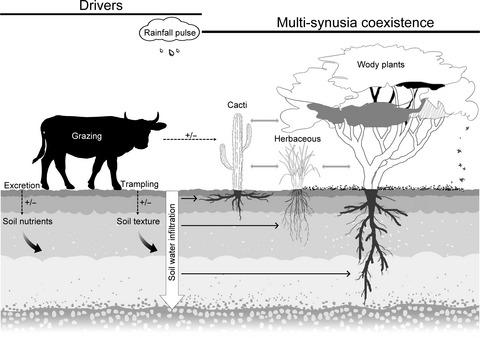当前位置:
X-MOL 学术
›
J. Appl. Ecol.
›
论文详情
Our official English website, www.x-mol.net, welcomes your feedback! (Note: you will need to create a separate account there.)
Rainfall pulses mediate long‐term plant community compositional dynamics in a semi‐arid rangeland
Journal of Applied Ecology ( IF 5.7 ) Pub Date : 2020-10-17 , DOI: 10.1111/1365-2664.13780 Maowei Liang 1, 2 , Xiao Feng 2, 3, 4 , Elise S. Gornish 2
中文翻译:

降雨脉冲介导半干旱牧场的长期植物群落组成动态
更新日期:2020-10-17
Journal of Applied Ecology ( IF 5.7 ) Pub Date : 2020-10-17 , DOI: 10.1111/1365-2664.13780 Maowei Liang 1, 2 , Xiao Feng 2, 3, 4 , Elise S. Gornish 2
Affiliation

|
- Semi‐arid rangelands, comprising more than 40% of the Earth's land surface, provide critical ecosystem services. Worldwide, these ecosystems are experiencing rapid degradation due to overgrazing and precipitation changes. However, how plants respond to these interacting factors remains relatively unexplored, and precisely which and how rainfall factors determine plant community dynamics in rangelands has not been well developed.
- We used a long‐term (1953‒2018) dataset from semi‐arid rangeland to investigate coupled effects of grazing intensity and rainfall intensity (the total amount of precipitation) on different groups of plant cover (herbaceous, woody and cacti plants) using linear mixed‐effects models, redundancy analysis and structural equation models. We examined how rainfall intensity influenced plant cover dynamics according to pulse size (intensity over time) categories, which we analysed at three scales: yearly, within the wet season only (June–September) and within the dry season only (October–May).
- Plant community cover showed a humpbacked trend in the last six decades, mostly through changes in woody plants. Although both grazing intensity and rainfall presented similar humpbacked trends with plant community cover, our models demonstrated that the reduction of plant cover from the 1990s has been mainly caused by a decrease of rainfall rather than grazing intensity, particularly due to profound reductions of the intensity of relatively small rainfall pulses (e.g. 5.1–15 mm/day) during the dry season. Specifically, these small rainfall pulses can increase plant cover of all subgroups of woody and herbaceous species, thereby increasing plant community cover. Moreover, rainfall pulses during the wet season had negative effects on herbaceous species and positive effects on woody plants. These results suggest a phenological niche partitioning between woody plants and herbaceous in subtropical rangelands.
- Synthesis and applications. Our results show how critical seasonal rainfall pulses are for regulating plant community compositional dynamics, which has significant implications for rangeland management and our ability to adapt and mitigate amplified climate influences in semi‐arid ecosystems.
中文翻译:

降雨脉冲介导半干旱牧场的长期植物群落组成动态
- 半干旱牧场占地球陆地面积的40%以上,可提供关键的生态系统服务。在全球范围内,由于过度放牧和降水变化,这些生态系统正在迅速退化。然而,植物如何对这些相互作用的因素作出反应尚待进一步研究,确切地说,降雨因素和降雨因素如何决定牧场的植物群落动态还没有得到很好的发展。
- 我们使用来自半干旱牧场的长期(1953‒2018)数据集,使用线性调查了放牧强度和降雨强度(降水总量)对不同植物覆盖类别(草皮,木本和仙人掌植物)的耦合效应混合效应模型,冗余分析和结构方程模型。我们根据脉冲大小(强度随时间的变化)类别检查了降雨强度如何影响植物的覆盖动态,我们对这三个尺度进行了分析:年度,仅在雨季(6月至9月)和仅在旱季(10月至5月) 。
- 在过去的六十年中,植物群落的覆盖率呈现出驼背的趋势,主要是由于木本植物的变化。尽管放牧强度和降雨在植物群落覆盖率上均表现出相似的驼峰趋势,但我们的模型表明,自1990年代以来植物覆盖率的下降主要是由于降雨的减少而不是放牧强度引起的,尤其是由于植被强度的显着降低。干旱季节的降雨脉冲相对较小(例如,5.1-15毫米/天)。具体而言,这些小的降雨脉冲可以增加木质和草本物种所有亚组的植物覆盖率,从而增加植物群落的覆盖率。此外,雨季的降雨脉冲对草本物种有负面影响,对木本植物有正面影响。
- 综合与应用。我们的结果表明关键的季节性降雨脉冲如何调节植物群落的组成动态,这对牧场管理以及我们适应和减轻半干旱生态系统中加剧的气候影响的能力具有重要意义。



























 京公网安备 11010802027423号
京公网安备 11010802027423号